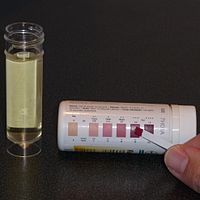
Photo from wikipedia
Background: Heterogeneity in the long-term metabolic response to dietary macronutrient composition can be partially explained by genetic factors. However, few studies have demonstrated reproducible gene-diet interactions (GDIs), likely due in… Click to show full abstract
Background: Heterogeneity in the long-term metabolic response to dietary macronutrient composition can be partially explained by genetic factors. However, few studies have demonstrated reproducible gene-diet interactions (GDIs), likely due in part to measurement error in dietary intake estimation as well as insufficient capture of rare genetic variation. Discovery analyses in ancestry-diverse cohorts that include rare genetic variants from whole-genome sequencing (WGS) could help identify genetic variants modifying the effects of dietary macronutrient composition on glycemic phenotypes. Objective: We aimed to identify macronutrient GDIs across the genetic frequency spectrum associated with continuous glycemic traits in genetically and culturally diverse cohorts. Methods: We analyzed N=33,187 diabetes-free participants from 10 cohorts in the NHLBI Trans-Omics for Precision Medicine (TOPMed) program with WGS, self-reported diet, and glycemic traits (fasting glucose [FG], insulin [FI], and hemoglobin A1c [HbA1c]). We fit multivariable-adjusted linear mixed models for the main effect of diet, modeled as an isocaloric substitution of carbohydrate for fat, and for its interactions with genetic variants genome-wide. Tests were performed for both common variants and gene-based rare variant sets in each cohort followed by a combined cohort meta-analysis. Results: In main effect models, participants consuming more calories from carbohydrate at the expense of fat had modestly lower glycemic trait values ({beta} per 250 kcal substitution for FG: -0.030 mmol/L, p=2.7x10-6; lnFI: -0.008 log(pmol/L), p=0.17; HbA1c: -0.013 %, p=0.025). In GDI analyses, a common African ancestry-enriched variant (rs79762542; 78 kb upstream of the FRAS1 gene) reached study-wide significance (p = 1.14x10-8) indicating a higher HbA1c with greater proportion of calories from carbohydrate vs. fat among minor allele carriers only. This interaction was replicated in the UK Biobank cohort. Simulations revealed that there is (1) a substantial impact of measurement error on statistical power for GDI discovery at these sample sizes, especially for rare genetic variants, and (2) over 150,000 samples may be necessary to identify similar macronutrient GDIs under realistic assumptions about effect size and measurement error. Conclusions: Our analysis identified a potential genetic interaction modifying the dietary macronutrient-HbA1c association while highlighting the importance of precise exposure measurement and significantly increased sample size to identify additional similar effects.
Journal Title: Diabetes
Year Published: 2022
Link to full text (if available)
Share on Social Media: Sign Up to like & get
recommendations!